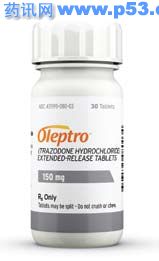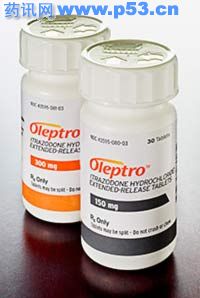|
每日1次曲唑酮制剂Oleptro获准用于治疗成人抑郁症
2010年2月3日,Labopharm公司宣布,美国食品药品管理局(FDA)已批准Oleptro (盐酸曲唑酮)用于治疗成人抑郁症(MDD)。Oleptro为缓释片剂,每日服用1次。
FDA批准Oleptro是基于对单相MDD患者进行的一项关键性研究的结果,该研究历时8周,为随机、双盲、2个亚组、多中心研究。其主要有效性终点为比较Oleptro治疗组与安慰剂对照组自基线起至研究结束时汉密尔顿抑郁量表(HAMD-17)总分的变化。主要终点达到统计学意义(P =0.012)。
此研究的总中止率为25%(安慰剂对照组为21%,Oleptro治疗组为30%)。Oleptro治疗组有4%的患者因嗜睡或镇静而中止治疗。
Oleptro最常见的不良反应为头晕、便秘、视物模糊以及嗜睡/镇静。药品说明书中包含一黑框警告,指出儿童、青少年及青年人因重度抑郁症及其他精神疾病接受抗抑郁药治疗后,有出现自杀意念及行为的风险。Oleptro尚未获准用于治疗儿科患者。
Manufacturer:
Labopharm, Inc.
Pharmacological Class:
Triazolopyridine
Active Ingredient(s):
Trazodone HCl 150mg, 300mg; scored ext-rel tabs.

Princeton, New Jersey (August 10, 2010) /PRNewswire/ — Angelini Labopharm today announced that OLEPTRO™ (trazodone hydrochloride extended-release tablets), a novel once-daily formulation of the antidepressant trazodone, is now commercially available in the United States. OLEPTRO™ is indicated for the treatment of major depressive disorder (MDD) in adults. The efficacy of OLEPTRO™ has been established in a trial of outpatients with MDD as well as in trials with the immediate release formulation of trazodone. OLEPTRO™ was approved by the U.S. Food and Drug Administration (FDA) on February 2, 2010. MDD is a common mental illness often characterized by a combination of emotional, somatic, and behavioral symptoms. It affects more than 14 million adults in the U.S. and is the leading cause of disability globally.
Nearly 28 percent of patients being treated with antidepressants stop taking their medication within the first four weeks of treatment and as many as 44 percent stop within the first 12 weeks, due to reasons such as lack of efficacy, exacerbation of symptoms, including sleep disturbance and agitation, and/or adverse events such as weight gain or sexual dysfunction.
“OLEPTRO™ offers physicians another therapeutic alternative for treating their patients with major depressive disorder,” said Dr. Jeffrey Dayno, Acting Chief Medical Officer of Angelini Labopharm. “This is important because we know that patients with MDD present unique profiles and respond differently to treatment – physicians appreciate options to better individualize patient care.”
“The launch of OLEPTRO™ is a significant milestone, not only for the depression community but also for Angelini Labopharm,” said Mary Anne Heino, Acting General Manager of Angelini Labopharm. “Bringing this important treatment to market represents the vision that Angelini and Labopharm had when they partnered together in the United States earlier this year.”
Labopharm and Angelini established Angelini Labopharm in May 2010 for the purpose of commercializing OLEPTRO™ in the United States. This partnership leverages the Contramid® technology platform from Labopharm with the experience of trazodone from Angelini.
About Major Depressive Disorder
MDD is a common mental illness often characterized by a combination of emotional, somatic, and behavioral symptoms. It affects more than 14 million adults in the U.S. and is the leading cause of disability globally. Approximately two times more prevalent in women than men, MDD often co-exists with other illnesses. Research shows that only approximately 65 percent of individuals with MDD are diagnosed and, of those patients, 90 percent are treated with medication.
About OLEPTRO™
OLEPTRO™ is a novel once-daily formulation of the antidepressant trazodone for the treatment of major depressive disorder (MDD) in adults.
OLEPTRO™ is an extended release formulation of trazodone hydrochloride, and uses Contramid®, Labopharm’s clinically validated technology to control the release of active substances within oral medications, whether taken whole or when broken along the score line. Contramid®, which allows for a high drug-loading capacity, forms a semi-permeable membrane that controls the release of medication throughout a 24 hour time period. The tablets may also be broken in half along the scored line without compromising the extended release properties due to a membrane that forms across the new inner surface of the broken tablet.
About Angelini Labopharm
For the purpose of marketing OLEPTRO™ in the United States, Angelini and Labopharm established the joint venture Angelini Labopharm, which is equally owned by both companies. This partnership leverages Labopharm’s Contramid® technology platform with Angelini’s experience of the trazodone molecule.
Important Safety Information About OLEPTRO™
For more complete information about OLEPTRO™, please see the full Prescribing Information and Medication Guide available at http://oleptro.com.
WARNING: SUICIDALITY AND ANTIDEPRESSANT DRUGS
See full prescribing information for complete boxed warning.
Increased risk of suicidal thinking and behavior in children, adolescents and young adults taking antidepressants for major depressive disorder (MDD) and other psychiatric disorders. Oleptro™ is not approved for use in pediatric patients.
Warnings and Precautions
Please see full prescribing information for complete description of Warnings and Precautions.
Clinical Worsening/Suicide Risk: Patients should be monitored for clinical worsening and suicidal thinking and behavior.
Serotonin Syndrome or Neuroleptic Malignant Syndrome-like Reactions: Have been reported with antidepressants. Symptoms: agitation, hallucinations, coordination problems, fast heart rate, tight muscles, trouble walking, nauseam vomiting and/or diarrhea. Oleptro™ use should be discontinued.
Activation of Mania/Hypomania: Screen for bipolar disorder and monitor for mania/ hypomania. Symptoms: feeling high or in a very good mood, then becoming irritable or having too much energy, feeling the need to keep talking or not sleeping (Mania).
QT Prolongation: Increases the QT interval. Avoid use with drugs that also increase the QT interval and in patients with risk factors for prolonged QT interval.
Use in Patients with Heart Disease: Use with caution in patients with cardiac disease.
Orthostatic Hypotension and Syncope: Have occurred. Patients should be made aware of risk and symptoms of hypotension (dizziness or faintness when changing positions).
Abnormal Bleeding: May increase the risk of bleeding. Use with NSAIDs, aspirin, or other drugs that affect coagulation may compound this risk.
Interaction with MAOIs: Do not use concomitantly or within 14 days of monoamine oxidase inhibitors.
Priapism: (erection lasting more than six hours) Has occurred. Male patients should be warned of this risk and how/when to seek medical attention.
Hyponatremia: (Low sodium in the blood) Can occur. Symptoms: headache, feeling weak and/or confused, trouble concentrating, memory problems, feeling unsteady when walking. Elderly patients, patients taking diuretics or patients who are dehydrated can be at greater risk.
Potential for Cognitive and Motor Impairment: Has potential to impair judgment, thinking, and motor skills. Patients should use caution when operating machinery.
Discontinuation Symptoms: May occur with abrupt discontinuation and include anxiety and sleep disturbance. Upon discontinuation, Oleptro™ dose should be decreased gradually and patients monitored for symptoms.
Pregnancy Category C: Oleptro™ should be used during pregnancy only if the potential benefit justifies the potential risk to the fetus.
Drug Interactions
Please see the full Prescribing Information for Oleptro™ for information about potential drug interactions.
Adverse Reactions
The most common adverse reactions (incidence greater than or equal to five percent and twice that of placebo) are: somnolence/sedation, dizziness, constipation, blurred vision. These are not all the possible adverse events of Oleptro™.

OLEPTRO
Indication(s):
Major depressive disorder.
Pharmacology:
Trazodone is believed to exert its antidepressant effects by potentiating serotonergic activity through selective inhibition of neuronal reuptake of serotonin. Trazodone also acts as an antagonist at the serotonin 5-HT2A/2C receptors. Activation of serotonin 5-HT2A/2C receptors, which studies have shown to be upregulated in patients with depression, inhibits dopamine and norepinephrine release which may contribute to depression. Trazodone does not stimulate the CNS.
Clinical Trials:
A randomized, double-blind, multicenter, two-arm trial was conducted to assess the efficacy of Oleptro in patients with unipolar major depressive disorder. The study, which randomized 412 adult patients, demonstrated a statistically significant difference in the Hamilton Rating Scale for Depression (HAMD-17) total score change from baseline at eight weeks between the Oleptro and placebo groups.
Legal Classification:
Rx
Adults:
May be swallowed whole or broken in half along the scored line; do not crush or chew. Take on empty stomach at bedtime. ≥18yrs: Initially 150mg once daily. May increase by 75mg/day at 3-day intervals; max 375mg/day.
Children:
<18yrs: not recommended.
Warnings/Precautions:
Monitor for clinical worsening, suicidality and unusual changes in behavior, esp. during initiation and dose changes. Acute post MI: not recommended. Monitor for serotonin syndrome or neuroleptic malignant syndrome-like symptoms; discontinue if occurs. Bipolar disorder. Mania/hypomania. Psychosis. Cardiovascular disease. Predisposition to QT prolongation. Hypokalemia. Hypomagnesemia. Renal or hepatic impairment. Volume depletion. Predisposition to priapism (eg, sickle cell anemia, multiple myeloma, leukemia, or anatomically deformed penis). Write Rx for smallest practical amount. Reevaluate periodically. Avoid abrupt cessation. Elderly. Pregnancy (Cat.C). Nursing mothers.
Interaction(s):
Do not use during or within 14 days of MAOIs. Concomitant trytophan: not recommended. Potentiates alcohol, barbiturates, other CNS depressants, digoxin, phenytoin, antihypertensives. Potentiated by CYP3A4 inhibitors (eg, ritonavir, indinavir, ketoconazole, itraconazole). Increased risk of arrhythmias with concomitant potent CYP3A4 inhibitors or drugs that prolong the QT interval; consider lower trazodone dose. Antagonized by CYP3A4 inducers (eg, carbamazepine). Increased risk of bleeding with concomitant NSAIDs, aspirin, anticoagulants. Monitor for serotonin syndrome with SSRIs, SNRIs, triptans (esp. during initiation and dose increases), MAOIs, antipsychotics, antidopaminergic agents. Monitor PT with warfarin. Increased risk of hyponatremia with diuretics.
Adverse Reaction(s):
Somnolence/sedation, dizziness, constipation, blurred vision, headache, anticholinergic effects, GI upset, fatigue, myalgia, hypotension, syncope, hyponatremia, sexual dysfunction, CNS disturbances, dyspnea, night sweats, QT prolongation, torsades de pointes (possible); rare: priapism (discontinue if occurs).
How Supplied:
Tabs—30
|



